Recent Posts
-
Yes, There IS a Future!
December 26, 2025
-
Real Crimes and the Coming Violence
September 6, 2025
-
Whither Modern Life?
June 27, 2025
-
What the Hell
June 18, 2025
-
As Darkness Engulfs Us
April 6, 2025
-
AI, Risk, and Work
January 17, 2025
-
“Things Are in the Saddle, and Ride Mankind”
December 29, 2024
-
Forgotten Futures in Seattle
December 12, 2024
-
Autocracy Defeats Neoliberalism
November 14, 2024
-
History… We’re Soaking in It!
October 2, 2024
|
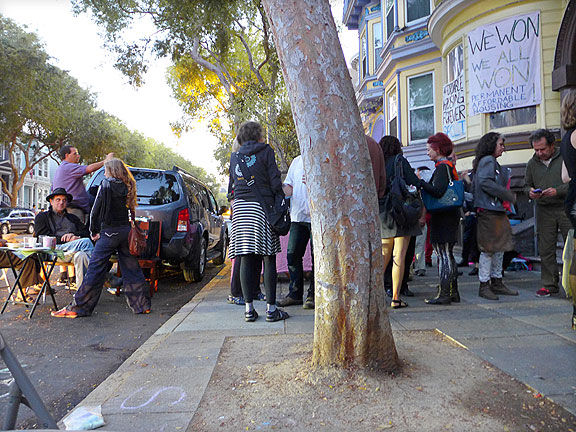 Sidewalk Party October 10, 2015, celebrating the successful purchase of the Pigeon Palace by the San Francisco Community Land Trust (closed Sept. 10, 2015). As a resident of San Francisco’s latest Community Land Trust property—the Pigeon Palace—I am enjoying the new peace of mind that comes from knowing that I will never be evicted from my home. I’ve been happily surprised to feel a subtle shift in my experience of daily life–I hadn’t realized how much I was preparing to leave until I was certain that I wouldn’t be forced out.
Over the past weeks I’ve enjoyed a number of very San Franciscan moments, from the annual SOMARTS opening party of the Day of the Dead altars, our own sidewalk celebration party, to bumping into a stream of friends while on my daily walks across the City. I’ve realized that we’re still here and we don’t have to leave. I’m here for the long haul, and with it comes both possibilities and responsibilities. I’m readier than ever to dig in and make this place truly ours.
Our building has had cheap rents and it is precisely these cheap rents that gave the tenants the safe and stable foundation that allowed us all to contribute so much to San Francisco’s cultural and political life for the past several decades. A low cost of housing is an essential foundation for a full life.
These days, everyone is bombarded by the hype to “do what you love,” and supposedly if you stick to it, the money will follow. Actually, probably not. Most of us have to get the proverbial “day job,” selling a money-making skill to someone willing to buy it. If we’re lucky we make enough money in few enough hours to leave us time to do what we really care about in our “free” time.
In my early 20s I realized that I wasn’t interested in following the normal paths that this society lays out before one. I wasn’t interested in a “career” and making money held no interest for me. I saw myself as a revolutionary and wanted to participate in creating a new way to live, not just for me as an individual, but a full-blown reorganization of everyday life itself. Even then I knew my revolutionary aspirations would probably not be met, so though I’ve continued to pursue that agenda in my own unique way, I also vowed to make sure that I lived the highest quality life I could manage. The key to that was to hold down my regular costs (transit, housing, food, communications, etc.) so that I would have less pressure to “slave away for the man!” In other words, I was way too busy to have a job! The best way I could carry out my self-directed activities (which have always kept me quite busy) was to bicycle instead of owning a car, to eat local and fresh from farmer’s markets and coop stores instead of eating out, and most crucially, to find and hold on to the lowest cost housing I could manage. Not having to make many thousands of dollars every month to be able to pass a large portion over to a landlord or bank gave me something far better than money; I have time, time that is not for sale. “Free” time is unmeasurable “wealth.” Cooperation, mutual aid, solidarity, and imagination all flourish in the absence of economic coercion. Happily, this dovetailed perfectly with my evolving sense of what a revolution might consist of.
Most people haven’t made the same choices that I have, and for many, it is nearly impossible to do so. My parents weren’t wealthy when I left home at age 17, but by the time I was in my 30s they were fairly affluent, and always ready and willing to back me up if I needed it. (I never really needed that backup, but having it available is clearly a big deal.) My chosen path to avoid economic coercion at all costs has given me a lot of freedom, and led to a lot of creative output over the years. But most people are trapped in poverty, or if they are “middle class” (as most people tend to think of themselves) the ball-and-chain of car ownership, the almost inevitable accumulation of student debt, and during the past twenty years radically rising housing costs, have entrapped most people in one type of debt or another. Burgeoning homelessness puts relentless pressure on those “lucky” enough to have an abode. Pay your rent, pay your mortgage, or else. After steadily rising housing costs in the last quarter of the 20th century, the 21st century saw an unprecedented transformation. Housing costs for renters and buyers alike skyrocketed in major cities across the planet, outracing stagnant incomes and becoming a primary conduit for transferring wealth from the majority of working people into the hands of a tiny financial elite.
Every apartment that is still rent-controlled, where long-term tenants pay less than $1000 per month per person (and sometimes much less!), has become a front line in the current battlefield of class war. Our fight to save our homes in the Pigeon Palace represents a victorious skirmish, and temporary reprieve for us, but so far, it is not going to be a working solution for many people.
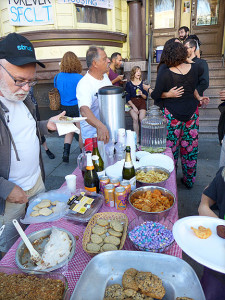 The Pigeon Palace Story The Pigeon Palace Story
At 83 our former landlady, who gave each of us very cheap rents because she didn’t believe in “choking people,” has been warehoused in a nursing home and denied any right of return to her home. A serious hoarder who was starting to lose her short-term memory and her mobility, but remained lucid and fiercely committed to her independence, she was declared incompetent by a judge and then relocated against her will by a court-appointed Conservator.
To save our homes we established a low-income, nonprofit housing co-op called Pigeon Palace, Inc. The San Francisco Community Land Trust (SFCLT), our political and economic partner (and benefactor) purchased the building in early September 2015 with loans from a private bank, the Mayor’s Office of Housing, and private investors including the tenants and our friends. With this purchase, we have taken the building off the market forever. But it came at a steep price that has saddled this effort with nearly $4 million in debt, a reality that casts a pall over our project and makes this a dubious model for widespread adoption or replication.
How did we manage to do this? The Pigeon Palace tenants joined with the San Francisco Community Land Trust (SFCLT) to “save” our building from the speculative real estate vultures that were hungrily circling our century-old 6-unit Victorian on Folsom Street in the heart of the Mission. The SFCLT won a probate auction, outlasting and outbidding one of the worst serial evictors in town. The Pigeon Palace was purchased at the height of the market for an absurdly high price. Our story, while inspiring on the face of it, sadly represents many of the worst contradictions that dominate the politics of housing not just in San Francisco but in every desirable city in the world.
Continue reading Forget Affordability: In Defense of Cheap Rent!
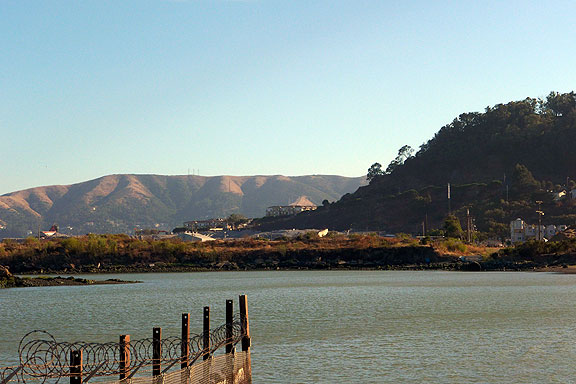 Candlestick Park is gone, but we’re still here! Took a good long break from the blog… partly I was writing other things, including the piece on “When Punk Mattered” I just posted before this. Partly I just wasn’t in the mood, and partly I’ve been quite preoccupied with our housing situation and also I began teaching a graduate seminar at USF this fall, so that took some effort to prepare for as well…
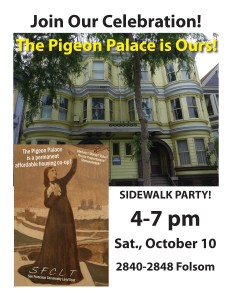 Come out and join us this Saturday for a sidewalk party! The good news: we are eviction-proof after a long summer of twists and turns that culminated in the successful closing of escrow on September 10. The Pigeon Palace is ours! For the next few years we’ll be renting from the San Francisco Community Land Trust, but in a few years we’ll go through a conversion process and come out the other end as a fully formed low-income housing cooperative and have a high degree of self-control and self-management over the building and our fates. Meanwhile, all around us San Francisco continues to undergo a staggering wave of displacement and disruption… the prognosis in just a few years is that we’ll be a weird pocket on Folsom Street in a thoroughly gentrified neighborhood. Imagine a co-op in Greenwich Village—that’s more or less where we’re headed now, irrespective of this small victory. That said, we’re mighty glad to have a safe and stable home from which we can continue to do all the work we’ve been doing all these years, whether radical history, anti-police violence organizing, queer dance and performance, AIDS activism, culinary interventions, or coming soon, support for other tenants to do what we’ve managed to do here.
I also spend a weird amount of time walking these days. My time is my major asset, and I use it well. My path crisscrosses the city’s hills and far-flung stairways and neighborhoods. Also just got back from a nice weekend in Lake Tahoe, a place I only barely passed by in the past, but this time enjoyed for a couple of days, hiking up to Lake Marlette above Tahoe, and circumnavigating much of the Lake during my visit. Between my urban treks and that Tahoe jaunt, I took a ton of photos. Here are a few more to finish off this brief howdy-doo to any readers who may still be waiting for me to get it together… Not sure about near-term regular posting, but I’ll keep this going one way or another. If you’re interested in anything in particular that you look forward to from me, drop me a line and let me know!
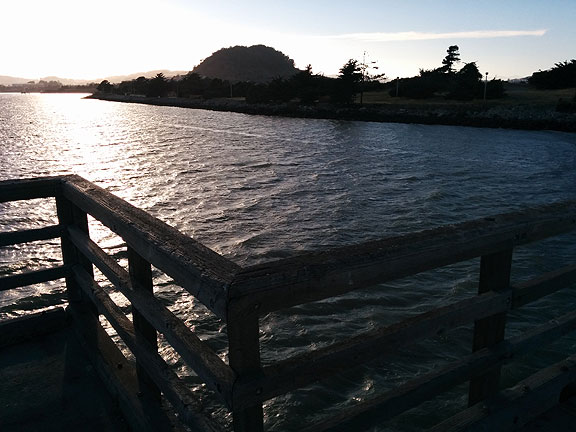 Off the end of the fishing pier at Candlestick Point State Recreation Area, the only urban park in the California State Park system.  Everyone went crazy for the Blood Moon the other night… seen here above 25th Street around the corner from home. 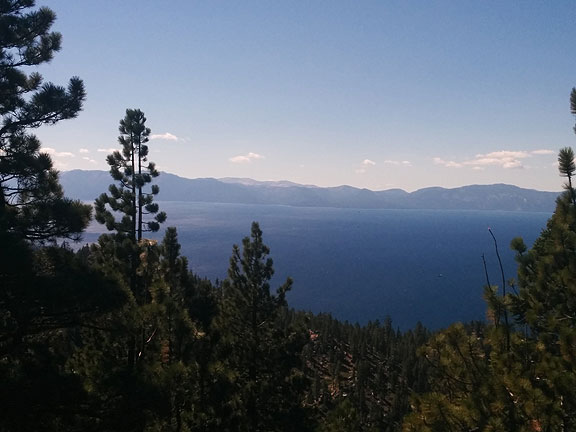 The rest of the images are from Lake Tahoe this past weekend… here seen from the trail to Lake Marlette.  I caught the moon over the western hills along the beach at South Lake Tahoe, rather sad in its depleted state after 3 years of drought. 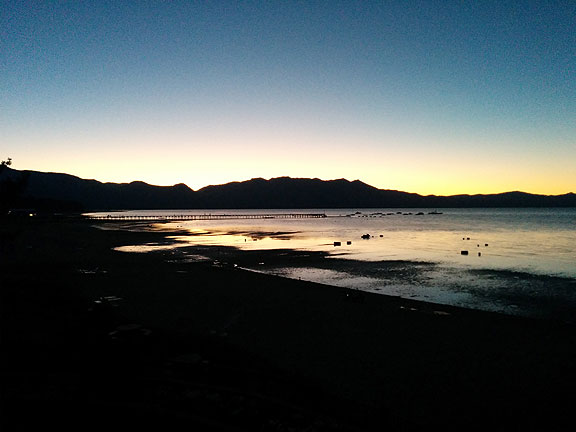 Same view from a balcony at our hotel, at sunset that night. 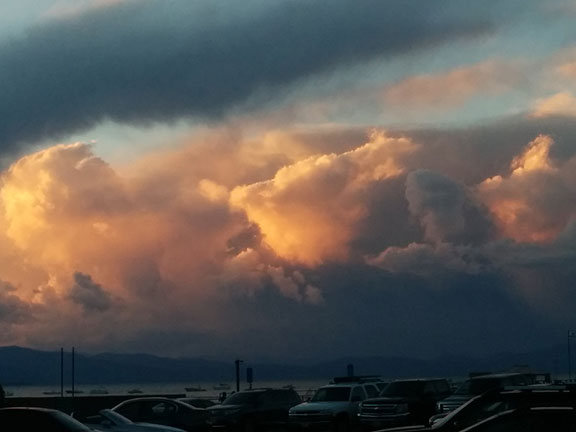 Wild clouds full of water, full of hope! It did rain one night while we were up in the mountains, but apparently not a drop in our bone-dry area.
Originally published in “Boom: The Journal of California”
Punk rock, hip-hop, reggae/dub and world music burst forth simultaneously and marked the receding waves of worldwide revolt that, in 1968, appeared on the verge of “changing the world.” They were an enunciation of failure and a denunciation of surrender… They carried forward a militance and internationalist spirit into the next phase of musical and political contestation, while exposing jagged rifts left by unsuccessful struggle.
-
-
- —Mat Callahan, The Trouble with Music
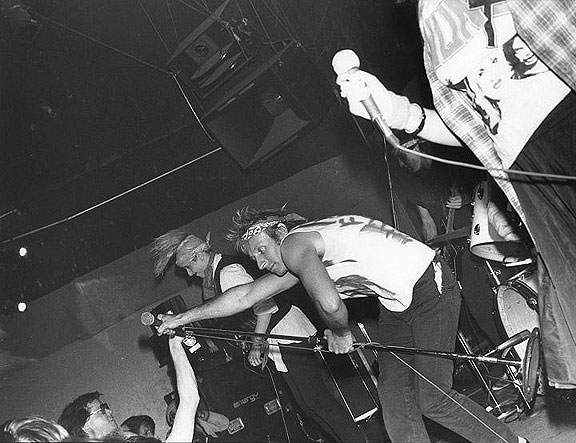 The Mutants, with Sue White, Fritz Fox, Sally Webster, in 1982. Photo: © Jeanne Hansen, 2015 We didn’t know it at the time. The revolution we thought was on the horizon was not going to overthrow capitalism or usher in an era of solidarity and mutual aid. On the contrary, the word “revolution” in the mid-to-late 1970s held a much darker potential. By the time Reagan got elected in 1980, the process of reasserting the power of capital over a recalcitrant and rebellious American working class was well underway. The “revolution” we would experience in the 1980s produced a massive U-turn, a return to the savage dog-eat-dog, everybody-for-herself, go-go capitalism that first emerged in the late nineteenth century. With several decades of hindsight, we can see now that we were at the dawn of the neoliberal city in those bleak days that for some of us felt so full of potential.
In San Francisco, we danced ourselves into a frenzy to the deafening punk rock of the Avengers, the Dils, the Mutants, the Dead Kennedys, and dozens of other bands, including touring British bands like The Clash, the Sex Pistols, the Buzzcocks, Stiff Little Fingers, Gang of Four, and many more. The music—brash, anthemic, compelling, and urgent—was the soundtrack of our time, a time we thought would finally banish the daily banality of pointless work and hollow consumerism, ubiquitous corruption, and imperial hubris that was at the heart of the tottering United States. The shows were in strange lost corners of San Francisco, the Deaf Club on the second floor of a Valencia Street building near Sixteenth; the Temple Beautiful, a huge abandoned Synagogue on Geary just west of Fillmore, next door to Jim Jones’s People’s Temple; Valencia Tool & Die, in a basement under Valencia near Twenty-first; the Mabuhay Gardens (Fab Mab), a Philippine eatery tucked among the strip clubs on Broadway in North Beach; 330 Grove Street, a fabled home to radical left and black political groups. But the epic sounds of revolt, the declarations of refusal, the hilarious ridiculing of the powerful and rich, the pointed satire of the emerging technosphere, turned out to be more of a last anguished demand to seize the moment between the lost utopias of the 1960s and early 1970s and the capitalist triumphalism that dominated the rest of the century.
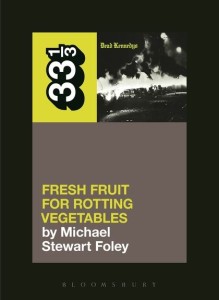 Michael Stewart Foley gives us a particular window on that musical revolt in his very enjoyable Fresh Fruit for Rotting Vegetables about the Dead Kennedys’ first album of the same name—Foley’s contribution to Bloomsbury’s 33 1/3 series of “books about albums.” Having their album as the spine of his narrative arc, Foley necessarily puts the Dead Kennedys at the center of the era. I loved the Dead Kennedys and saw them many times between 1978 and 1981, but I remember them rather differently than his account has it. They were part of a much larger and strongly politicized culture that flourished in San Francisco during that mostly forgotten interregnum between what we might call the “long sixties” and the Reagan restoration. The punk/new wave scene was a very visible and dynamic element, but radical politics were percolating in many forms and places alongside the punk music scene. Copying machines were finally becoming cheap and accessible, and many people began putting their collages, screeds, and cartoons on the poles and walls of San Francisco. Underground radio gained new life on local college stations KUSF and KALX, providing vital airtime for obscure bands from near and far. DJs like George Epileptic filled three hours every weekday morning with the biting satire and the angry sounds of dozens of new bands basically saying “Fuck you” to mainstream America. Meanwhile, the antinuclear Abalone Alliance was mobilizing thousands to block PG&E’s plans to build a nuclear power plant on the coast at Diablo Canyon; Nicaraguan revolutionaries and Iranian students crisscrossed the Bay Area urging support for the overthrow of the US-sponsored dictators in their respective countries; tenants were organizing for rent control in the wake of the violent eviction of the I-Hotel in 1977; and strikes at local oil refineries, trucking operations, insurance offices, and restaurant chains dovetailed with a national coal miners’ strike. President Jimmy Carter moved steadily rightward throughout his presidency, and being a former Navy nuclear engineer, in fact, rather than the “peanut farmer” of his mythology, he was increasingly seen, at least in our circles, as a deeply reactionary tool of the military-industrial complex. For many of us, the prospect of Carter losing to Reagan was inconceivable, the country having slid so far right under his regime that there was no way it could go further—add this to a long list of our badly off-the-mark prognostications! One local street theater group took the name “Reagan for Shah” to dramatize the absurdity of his campaign. Michael Stewart Foley gives us a particular window on that musical revolt in his very enjoyable Fresh Fruit for Rotting Vegetables about the Dead Kennedys’ first album of the same name—Foley’s contribution to Bloomsbury’s 33 1/3 series of “books about albums.” Having their album as the spine of his narrative arc, Foley necessarily puts the Dead Kennedys at the center of the era. I loved the Dead Kennedys and saw them many times between 1978 and 1981, but I remember them rather differently than his account has it. They were part of a much larger and strongly politicized culture that flourished in San Francisco during that mostly forgotten interregnum between what we might call the “long sixties” and the Reagan restoration. The punk/new wave scene was a very visible and dynamic element, but radical politics were percolating in many forms and places alongside the punk music scene. Copying machines were finally becoming cheap and accessible, and many people began putting their collages, screeds, and cartoons on the poles and walls of San Francisco. Underground radio gained new life on local college stations KUSF and KALX, providing vital airtime for obscure bands from near and far. DJs like George Epileptic filled three hours every weekday morning with the biting satire and the angry sounds of dozens of new bands basically saying “Fuck you” to mainstream America. Meanwhile, the antinuclear Abalone Alliance was mobilizing thousands to block PG&E’s plans to build a nuclear power plant on the coast at Diablo Canyon; Nicaraguan revolutionaries and Iranian students crisscrossed the Bay Area urging support for the overthrow of the US-sponsored dictators in their respective countries; tenants were organizing for rent control in the wake of the violent eviction of the I-Hotel in 1977; and strikes at local oil refineries, trucking operations, insurance offices, and restaurant chains dovetailed with a national coal miners’ strike. President Jimmy Carter moved steadily rightward throughout his presidency, and being a former Navy nuclear engineer, in fact, rather than the “peanut farmer” of his mythology, he was increasingly seen, at least in our circles, as a deeply reactionary tool of the military-industrial complex. For many of us, the prospect of Carter losing to Reagan was inconceivable, the country having slid so far right under his regime that there was no way it could go further—add this to a long list of our badly off-the-mark prognostications! One local street theater group took the name “Reagan for Shah” to dramatize the absurdity of his campaign.
Reading Foley’s Dead Kennedys book brought me back into those first years of my life in San Francisco. It’s hard to imagine now.
Continue reading When Punk Mattered: At the Dawn of the Neoliberal City
|
Hidden San Francisco 2nd EDITION!

NEW 2nd EDITION NOW AVAILABLE!
Buy one here
(Pluto Press, Spring 2025)
|























